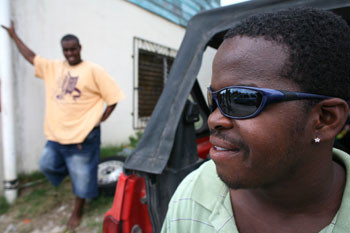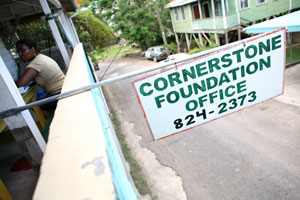News
Preventing HIV Among Youth Living on the Fringes in Belize
- 16 August 2007
News
BELIZE CITY, Belize — Raymond Gentle (32) is the owner of a convenience store on Belize City’s infamous South Side. His narrow glance, gold-capped teeth, tattoos and baseball cap tilted to the side suggest he's not your average ‘mom and pop’ business owner.
When asked about his role as a gang leader, he responds: “People say [I am]…the police say so.” But he does not fit the image of a Central American ‘marero’ or gang member, widely regarded as dangerous and unscrupulously violent. He is a father of two, and he wants his kids to grow up with a chance at making an honest living.
Gang membership on the South Side of Belize City seems to practically be assigned at birth. There are no initiation rites for membership. If you live on Craw Road, chances are you will be a member of the Craw Road Gang.

Alternatives to 'hanging out'
Gentle is a gang leader who openly admits that members rob, steal and fight other gangs on the South Side, but at the same time, he helps organize sports events for neighbourhood children to offer an alternative to “hanging out on the street and smoking weed.” He seems to understand there is no excuse for illegal activities, and says he doesn’t want the next generation to “grow up like that.”
"Another time, someone pointed a gun to my head when I urged them to turn their life around and go back to school. "
--Douglas Hyde
Gentle volunteers with Youth for the Future, a non-governmental organization that forms part of a regional project to prevent HIV infection among vulnerable young people. Even though his attitude towards the HIV prevention work is positive, not everybody welcomes the YFF volunteers.
“I was once hit in the head with a broken bottle," recalls Douglas Hyde, an official with the Belizean Ministry of Youth and a coordinator of the Youth for the Future prevention programme. "Another time, someone pointed a gun to my head when I urged them to turn their life around and go back to school.” Several of the volunteers who were ex-gang members have been killed over the past years.
Reaching out to those living on the fringes
The initiative, Prevention of HIV/AIDS Among Youth in Especially Difficult Circumstances, is financed by the OPEC Fund for International Development and UNFPA, the United Nations Population Fund.
Working with gang members is only a small part of the programme’s many activities, which are spread over six Central American and Caribbean countries (Costa Rica, Guatemala, Guyana, Honduras and St. Lucia, in addition to Belize). The programme ended officially last June at a regional meeting in Belize City, but participants hope that at least some of the activities will continue. High-level political support for HIV prevention, as well as mobilization of youth, are just two of its major achievements.

Activities in Belize involve a wide range of organizations, such as the 4H, the Cadet Corp (a type of correctional facility for males between the ages of 13 and 18), the United Belize Advocacy Movement—a group representing men who have sex with men, and a community-based organization called the Cornerstone Foundation.
Belize’s YWCA (Young Women’s Christian Organization), another participant, helps educate young women about HIV prevention and teaches them vocational skills to prepare them for adulthood.
Mixing hair cuts with health messages
Marleni Espinoza (17) is among those who have benefited from this programme.
“I didn’t get good grades in school, so I decided to learn about working in a beauty parlour,” says Marleni. She was part of the so-called barbershop programme where hairdressers learn how to protect themselves and their customers from HIV infection.
The Slip’n Slide barbershop in Belize City is among the participating establishments. Its owner, Anthony Lofter, explains that he often talks to customers about HIV prevention and hands out condoms to some of them. The programme, which includes a number of Belize City barber shops, offers free advertising as an incentive. Lofter says he thinks this has helped him increase his customer base.
Belize, a tiny Caribbean nation of 270,000 inhabitants wedged between Mexico and Guatemala, has one of the highest HIV prevalence rates in the region. UNAIDS estimates that 2.5 per cent of Belizeans between 15 and 49 years old are HIV positive, or have developed AIDS. The Caribbean as a whole has the second highest HIV prevalence rate in the world—ranging between 1 and 3.5 per cent of the population, with Haiti at the upper end of the scale. It is topped only by sub-Saharan Africa.
Working to end stigma and discrimination
San Ignacio seems far removed from Belize City’s violent South Side, even though it is barely a couple of hours drive away. The small but bustling city located 10 kilometres (6.7 miles) from the Guatemalan border, calls itself a destination for adventure tourism. It also serves as headquarters for the Cornerstone Foundation, a small community-based organization that runs a variety of HIV prevention programmes.
The OPEC Fund/UNFPA project has helped the Cornerstone Foundation print and distribute educational material for use in local schools, and distribute HIV prevention pamphlets and condoms to about 20 local hotels. “About three or four years ago, it seemed that everyone here knew someone who was HIV positive. That is when we experienced an influx of requests for education,” says Pamela VanDeusen, an international development consultant working for Cornerstone. “Now we need to reach a deeper level and end discrimination and stigma against those who are HIV positive."
— Trygve Olfarnes